Table of Contents
Table of Contents
- Introduction: A Crisis Hidden in Plain Sight
- Key Takeaways: What You Need to Know Right Now
- The 2025 Compliance Crisis: Understanding the Scale of the Problem
- Understanding UK Fire Safety Regulations: Your Complete Legal Framework
- March 2025 Regulatory Updates: What Changed and Why It Matters
- Responsibilities and Legal Compliance: Who Does What and When
- Fire Door Specifications and Technical Requirements: Getting the Details Right
- Fire Resistance Classifications: The New European Standard
- Essential Fire Door Components: Building Safety from the Ground Up
- Specialized Fire Door Applications
- Hardware Requirements: The Critical Details
- Sealing Systems: Preventing Smoke and Flame Penetration
- External Fire Door Considerations
- Fire-Rated vs Fire-Proof Terminology
- Professional Inspection and Maintenance: Ensuring Ongoing Compliance
- Cost Analysis and Return on Investment: Making the Business Case
- Conclusion: Taking Action for Safety and Compliance
Introduction: A Crisis Hidden in Plain Sight
Imagine walking through your building, confident that every fire door is protecting lives and property. Now imagine discovering that 85% of those doors would fail a professional inspection. This isn’t a hypothetical scenario – it’s the shocking reality facing UK building owners in 2025.
Recent comprehensive analysis of over 50,000 fire door inspections across the United Kingdom has revealed the most serious fire safety compliance crisis in the nation’s history. With average fines now reaching £45,000 and some healthcare facilities reporting 100% failure rates, the time for action is now.
This guide will walk you through everything you need to know about fire door compliance in 2025, from understanding the latest regulations to implementing effective monitoring systems. Whether you’re a building owner, facilities manager, or compliance officer, this comprehensive resource will help you navigate the complex landscape of UK fire safety requirements and understand where fire doors are required in the UK.
Key Takeaways: What You Need to Know Right Now
| Category | 2025 Critical Updates |
| Compliance Crisis | 85% of UK fire doors fail British standards during professional inspections |
| March 2025 Updates | BS EN 13501 European standards now mandatory, replacing BS 476 |
| Healthcare Emergency | Some healthcare sectors report 100% failure rates |
| Survey Requirements | Professional fire door surveys mandatory every 3-6 months |
| Cost of Non-Compliance | Average fines increased 65% to £45,000 in 2024 |
| New Technology | IoT monitoring systems revolutionizing compliance management |
| Legal Consequences | 234 prosecution cases in 2024 for fire door violations |
| Market Impact | £2.3 billion remediation market over next 5 years |
The 2025 Compliance Crisis: Understanding the Scale of the Problem
National Emergency: The Numbers Don’t Lie
The latest fire door inspection data reveals a national crisis that demands immediate attention. Recent comprehensive analysis of over 50,000 fire door inspections across the UK has exposed a shocking reality: 85% of fire doors fail to meet British standards during professional assessments.
This represents the most serious fire safety compliance crisis in UK history, with implications that extend far beyond simple regulatory non-compliance. The failure rate varies significantly across different sectors and regions, painting a complex picture of systemic issues that require urgent intervention.
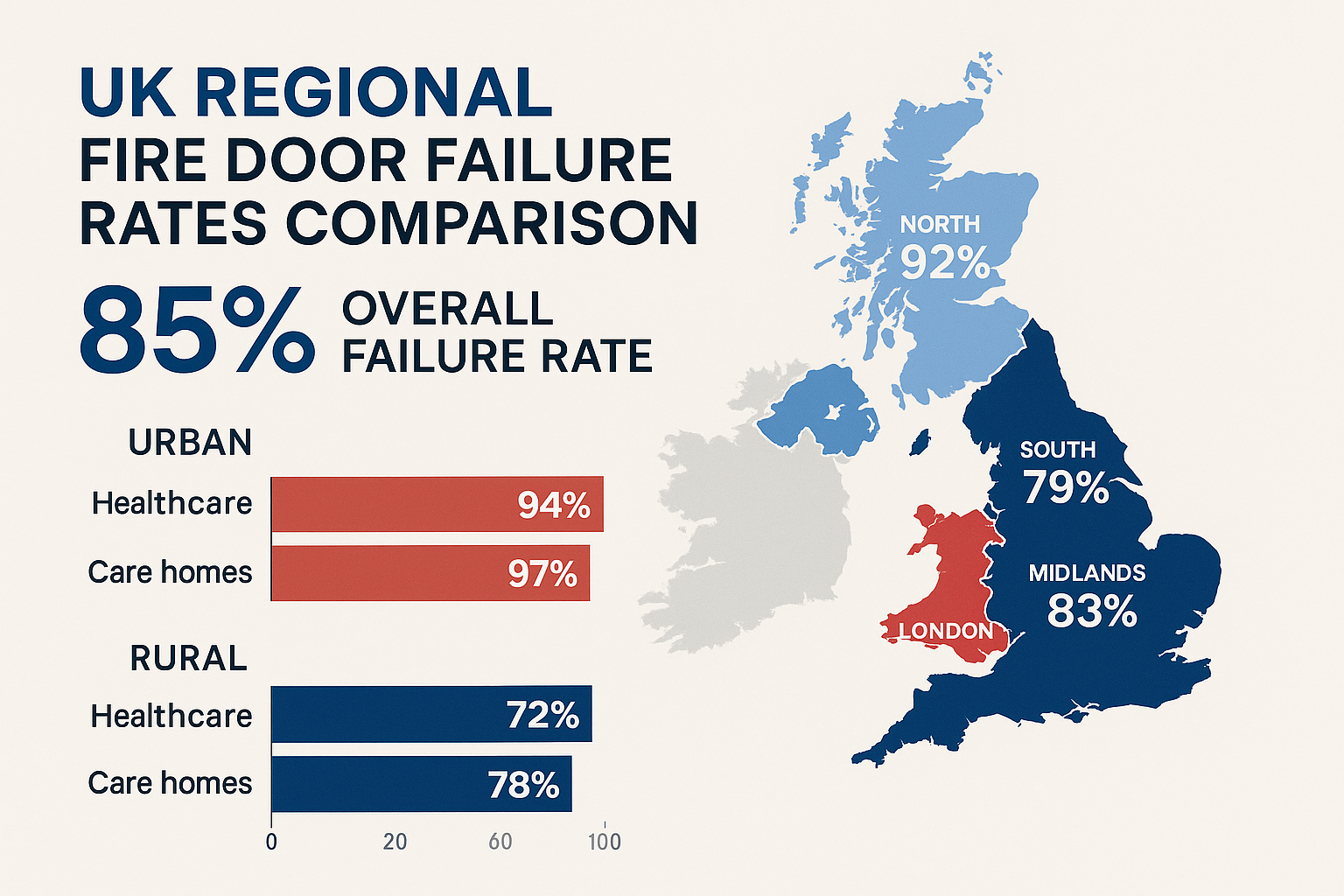
Figure 1: UK Regional Fire Door Failure Rates – Urban vs Rural Comparison showing 85% overall failure rate with London at 89%, healthcare facilities at 94%, and care homes at 97%
Breaking Down the Crisis by Numbers
The statistics paint a sobering picture of the current state of fire door compliance across the United Kingdom:
Overall Failure Statistics:
- 85% overall failure rate across all building types
- 31% of doors incorrectly installed from initial construction
- 75% of failed doors could be repaired with proper maintenance
- £2.3 billion required for nationwide remediation over the next five years
London Fire Brigade Data shows the capital facing the worst crisis:
- Urban areas: 89% failure rate (highest in UK)
- Social housing: 91% non-compliance rate
- Private residential: 82% failure rate
- Commercial properties: 76% failure rate
Healthcare Sector Crisis reaches emergency levels:
- NHS trusts: 94% failure rate
- Care homes: 97% failure rate
- Private healthcare: 89% failure rate
- Mental health facilities: 100% failure rate in some regions
These figures represent more than statistical data – they represent a clear and present danger to public safety. The healthcare sector’s particularly high failure rates are especially concerning, given the vulnerable populations these facilities serve and the critical importance of fire safety in medical environments.
Understanding the Root Causes
The crisis stems from three primary sources of failure, each requiring different approaches to resolution:
Installation Failures (31% of cases): Installation problems represent nearly one-third of all failures, indicating systemic issues in the construction and renovation industries. Common installation failures include incorrect gap tolerances exceeding the 4mm maximum, missing or inadequate intumescent strips for fire doors, installation of non-fire-rated hardware, and poor frame-to-wall fixing that compromises the door’s integrity.
Maintenance Neglect (45% of cases): The largest category of failures stems from inadequate ongoing maintenance. This includes damaged self-closing mechanisms that prevent doors from closing properly during emergencies, painted-over seals and fire strips for doors that lose their fire-resistant properties, door warping from building settlement that creates dangerous gaps, and hardware replacement with non-compliant components that void fire ratings.
Regulatory Ignorance (24% of cases): A significant portion of failures results from simple lack of awareness about current requirements. Many building owners and managers remain unaware of the Fire Safety (England) Regulations 2022, have insufficient fire risk assessment cost planning procedures, lack professional fire door surveys, demonstrate inadequate understanding of fire extinguisher testing schedules and emergency light testing compliance, and provide insufficient staff training and awareness programs.
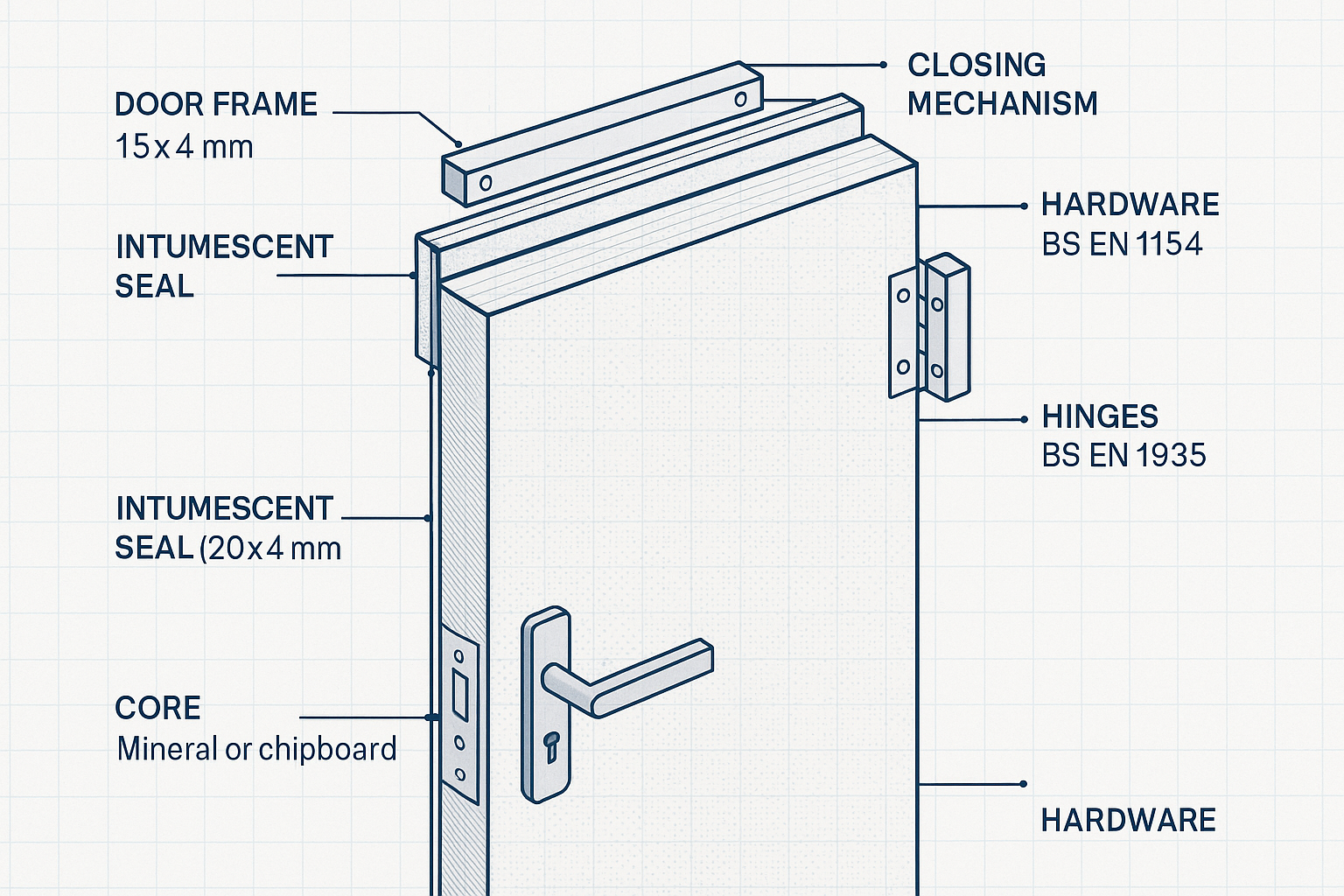
Figure 2: Technical Components and Standards for Compliant Fire Door Construction showing door frame, intumescent seals, hinges, closing mechanism, core materials, and hardware specifications
The Immediate Action Imperative
This crisis demands immediate action to prevent potential loss of life and ensure legal compliance under current UK regulations. The scale of the problem means that building owners cannot afford to wait for gradual improvement – decisive action is required now.
For Building Owners, immediate steps include: Conducting emergency professional surveys within 30 days, performing comprehensive risk assessments of all failed doors, implementing temporary safety measures where necessary, and developing remedial action plans with qualified contractors. Understanding who is responsible for fire doors in flats is crucial for residential property owners.
For Responsible Persons, urgent actions include: Documenting the current status of all fire doors, implementing monthly monitoring protocols until full compliance is achieved, engaging professional fire door specialists for assessment and remediation, coordinating with fire alarm testing schedules, reviewing emergency light testing compliance, and updating fire safety procedures and staff training programs.
The cost of inaction far exceeds the investment required for compliance. With average fines now reaching £45,000 and the potential for criminal prosecution, the financial and legal risks of maintaining non-compliant fire doors have never been higher.
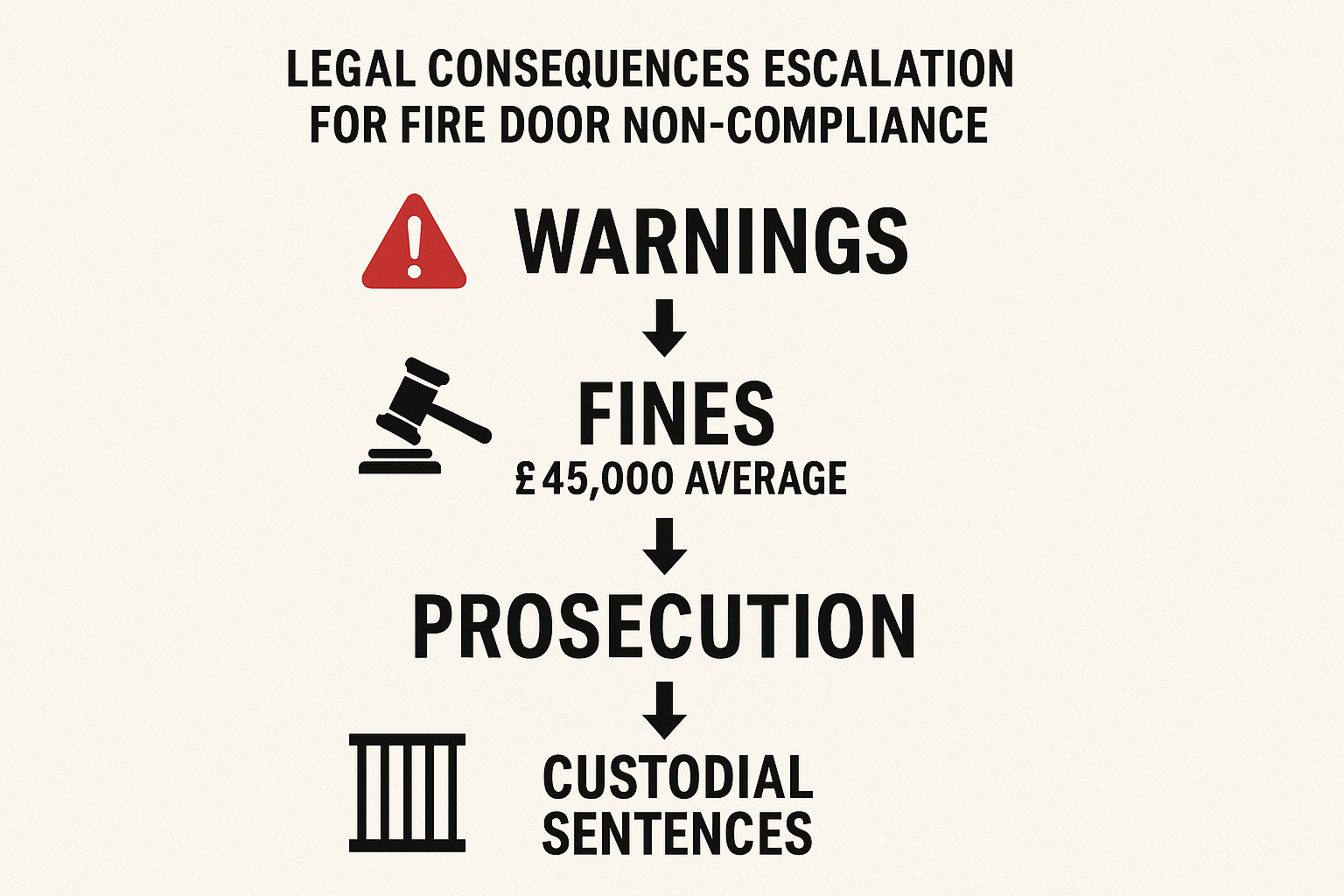
Figure 3: Legal Consequences Escalation for Fire Door Non-Compliance showing progression from warnings to £45,000 fines, prosecution, and custodial sentences
Understanding UK Fire Safety Regulations: Your Complete Legal Framework
Fire safety in the United Kingdom operates under a comprehensive framework of interconnected regulations designed to protect lives and property. For building owners and managers in 2025, understanding these regulations isn’t just about compliance – it’s about ensuring the safety of everyone who enters your building.
The Foundation: Regulatory Reform (Fire Safety) Order 2005
The Regulatory Reform (Fire Safety) Order 2005 serves as the cornerstone of UK fire safety law, establishing clear responsibilities for “Responsible Persons” – typically building owners, employers, or managing agents. This order places the burden of fire safety squarely on those who control premises, making them legally accountable for ensuring comprehensive fire safety measures.
Key Responsibilities Under the Order:
The order requires Responsible Persons to conduct comprehensive fire risk assessments that cover all aspects of fire safety, including fire door functionality and maintenance. These assessments must implement appropriate fire safety measures, including understanding fire triangle prevention principles and different fire classifications such as Class A fires and Class B fires. Responsible Persons must maintain all fire doors and safety equipment to manufacturer specifications, coordinate fire extinguisher testing schedules with door inspections, provide comprehensive staff training and emergency procedures, and keep detailed records for a minimum of five years.
Understanding why fire doors should be kept closed is fundamental to fire safety management, as open fire doors cannot provide protection during emergencies.
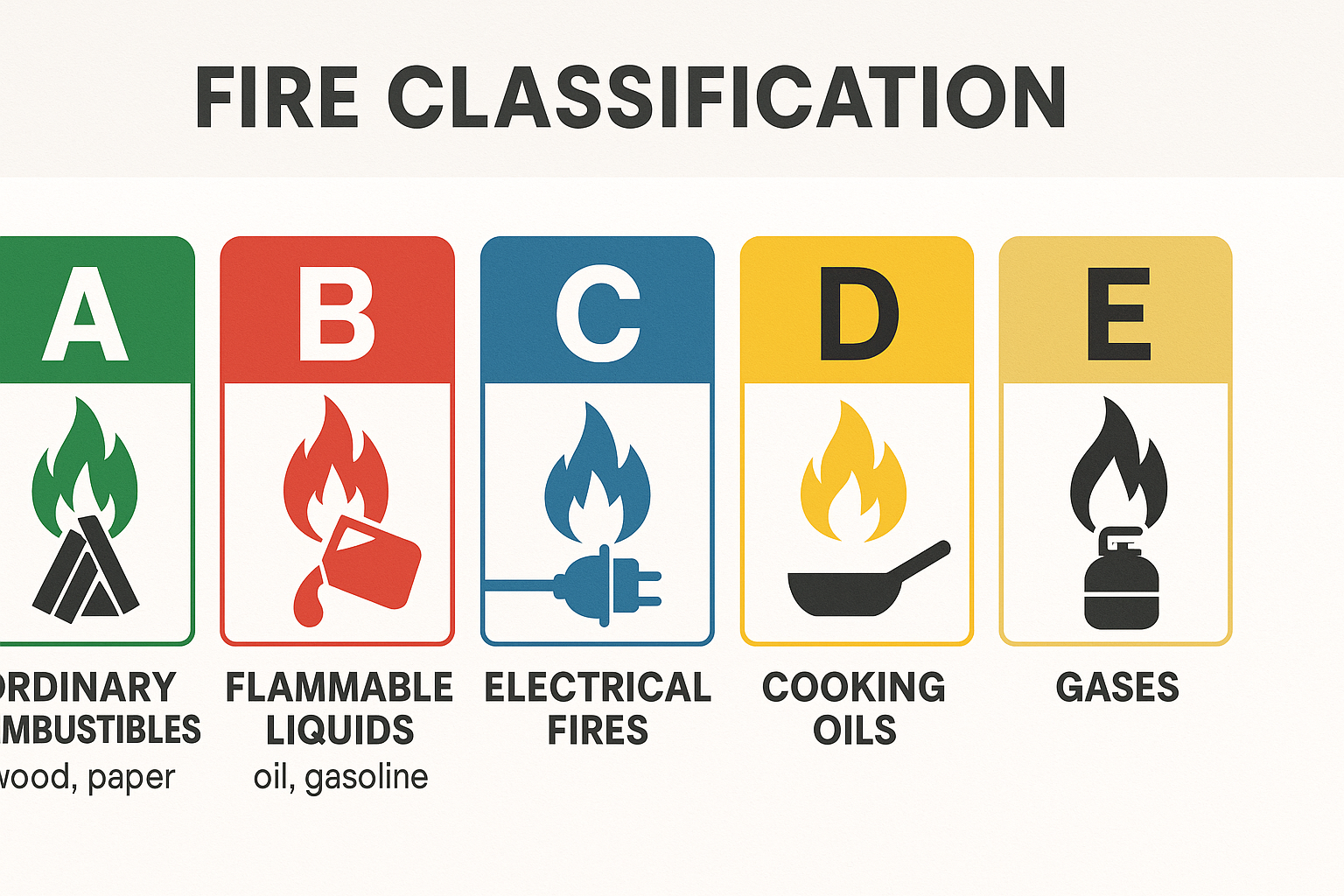
Figure 4: Fire Classification Guide showing Class A (ordinary combustibles), Class B (flammable liquids), Class C (electrical), Class D (cooking oils), and Class E (gases)
2025 Enforcement Statistics Paint a Clear Picture:
The enforcement landscape has become increasingly stringent, with 234 prosecution cases filed for fire door violations alone in 2024. Average fines have reached £45,000, representing a 65% increase from 2023 levels. Most concerning, 12 custodial sentences were imposed on Responsible Persons who failed to meet their legal obligations, while total fines for fire door non-compliance reached £2.3 million across all cases.
Game-Changing Legislation: Fire Safety (England) Regulations 2022
Effective from 23 January 2023, the Fire Safety (England) Regulations 2022 specifically target multi-occupied residential buildings over 11 meters in height, introducing unprecedented requirements for fire door management and monitoring.
Mandatory Requirements Transform Building Management:
These regulations require quarterly inspections of communal fire doors by qualified professionals, annual checks of flat entrance doors with detailed documentation, resident notification systems for fire door safety information, digital record keeping for a minimum of seven years, and professional fire door surveys by accredited assessors with recognized qualifications. Understanding how often fire doors need to be inspected is crucial for compliance with these new requirements.
Building Coverage Extends Across Multiple Property Types:
The regulations apply to all residential blocks over 11 meters requiring comprehensive fire risk assessment cost planning, mixed-use developments with residential components, student accommodation and HMO fire risk assessment properties, and supported living facilities and care homes with integrated wireless smoke alarm systems.
For residential properties, understanding fire doors for flats requirements is essential, as these doors often serve as the primary barrier between individual units and common areas.
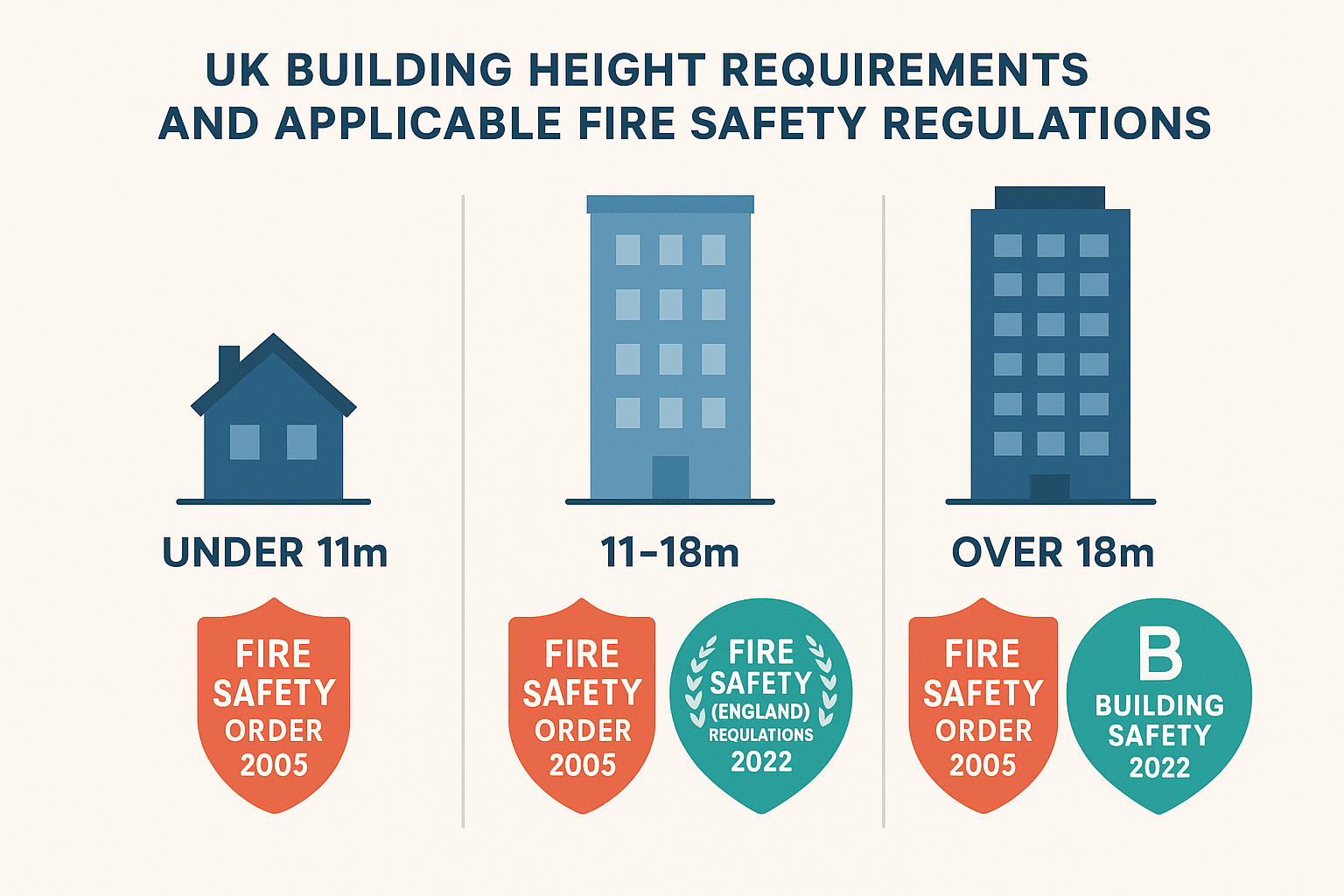
Figure 5: UK Building Height Requirements and Applicable Fire Safety Regulations showing Fire Safety Order 2005, Fire Safety England Regulations 2022, and Building Safety Act 2022 applications
Revolutionary Changes: Building Safety Act 2022
The Building Safety Act 2022 represents revolutionary legislation introduced following the Grenfell Tower tragedy, focusing specifically on high-rise residential buildings and introducing personal liability for building safety management.
Enhanced Requirements for Buildings 18m+ or 7+ Storeys:
The Act requires designation of a Principal Accountable Person (PAP) with personal liability for building safety, maintenance of digital building safety cases with live updating capabilities, implementation of resident engagement strategies including fire door information sharing, monthly fire door monitoring for high-risk buildings, and deployment of AI-powered compliance systems for real-time monitoring and reporting.
Clarifying Responsibilities: Fire Safety Act 2021
The Fire Safety Act 2021 clarifies responsibilities for external walls, structure, and flat entrance doors in multi-occupied residential buildings, closing gaps in previous legislation.
Key Provisions Include:
The Act mandates external wall assessments that integrate with fire door systems, structural fire safety considerations that account for door performance, enhanced enforcement powers for fire and rescue services, and resident consultation requirements on fire safety measures including door maintenance and replacement. For buildings with external fire doors, understanding these requirements is particularly important.
Integration with Building Regulations
Approved Document B (Fire Safety) works alongside fire safety orders to ensure new construction and major renovations meet current standards, with significant updates taking effect in March 2025.
2025 Key Changes Include:
BS EN 13501 European standards are now mandatory for all fire door installations, enhanced documentation requirements for building control approval, third-party verification requirements for complex installations, and digital door registers for buildings over 11 meters integrated with comprehensive fire safety management systems.
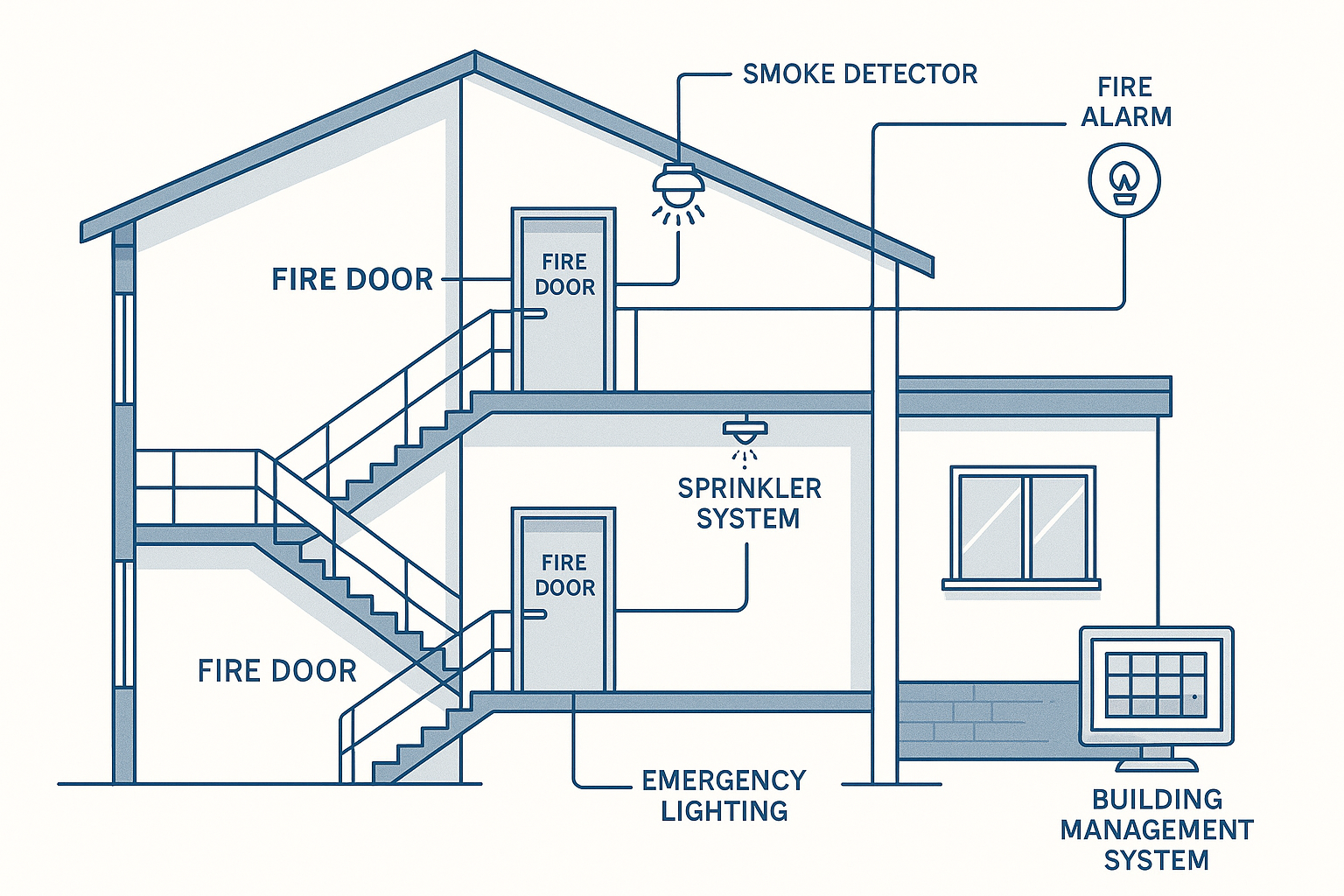
Figure 6: Integrated Fire Safety Systems showing fire doors connected to alarms, sprinklers, emergency lighting, smoke detectors, and building management systems
March 2025 Regulatory Updates: What Changed and Why It Matters
March 2025 marked a watershed moment in UK fire safety regulation, with amendments representing the most substantial changes to fire door requirements in over a decade. These updates fundamentally alter how fire doors are tested, certified, and maintained across the United Kingdom.
Revolutionary Transition: BS EN 13501 European Standards
The most significant change involves the complete phase-out of national fire reaction classifications (BS 476) in favor of the BS EN 13501 European classification system. This transition represents more than a simple regulatory update – it’s a fundamental shift toward harmonized European standards that provide more detailed and accurate fire performance data.
Impact on Fire Door Systems:
All fire doors must now be tested and certified to BS EN 13501 standards, with CE Marking becoming mandatory on all construction products. The enhanced performance classifications provide more detailed fire resistance data than previous systems, while harmonization with European protocols ensures international compliance for multinational organizations.
This affects all types of fire doors, including internal fire doors, commercial fire doors, and specialized applications like steel fire doors used in industrial settings.
Understanding the New Classification System:
The transition from BS 476 to BS EN 13501 involves significant changes in how fire performance is measured and reported. The old BS 476 Class 0 classification now corresponds to BS EN 13501 Class B-s1, d0, providing much more specific information about fire behavior. Fire resistance periods are now classified as R30, R60, R90, and R120, indicating the number of minutes the door can withstand fire exposure. Smoke production ratings (s1, s2, s3) are now mandatory, providing crucial information about smoke generation during fire exposure. Flaming droplet classifications (d0, d1, d2) are required, indicating whether burning droplets fall from the door during fire exposure.
Timeline for Compliance:
The implementation follows a phased approach designed to minimize disruption while ensuring safety. As of March 2025, all new installations must use BS EN 13501 certified products. By September 2025, all existing doors require recertification under the new standards. Full enforcement with penalties begins in January 2026, giving building owners time to achieve compliance while maintaining safety standards.
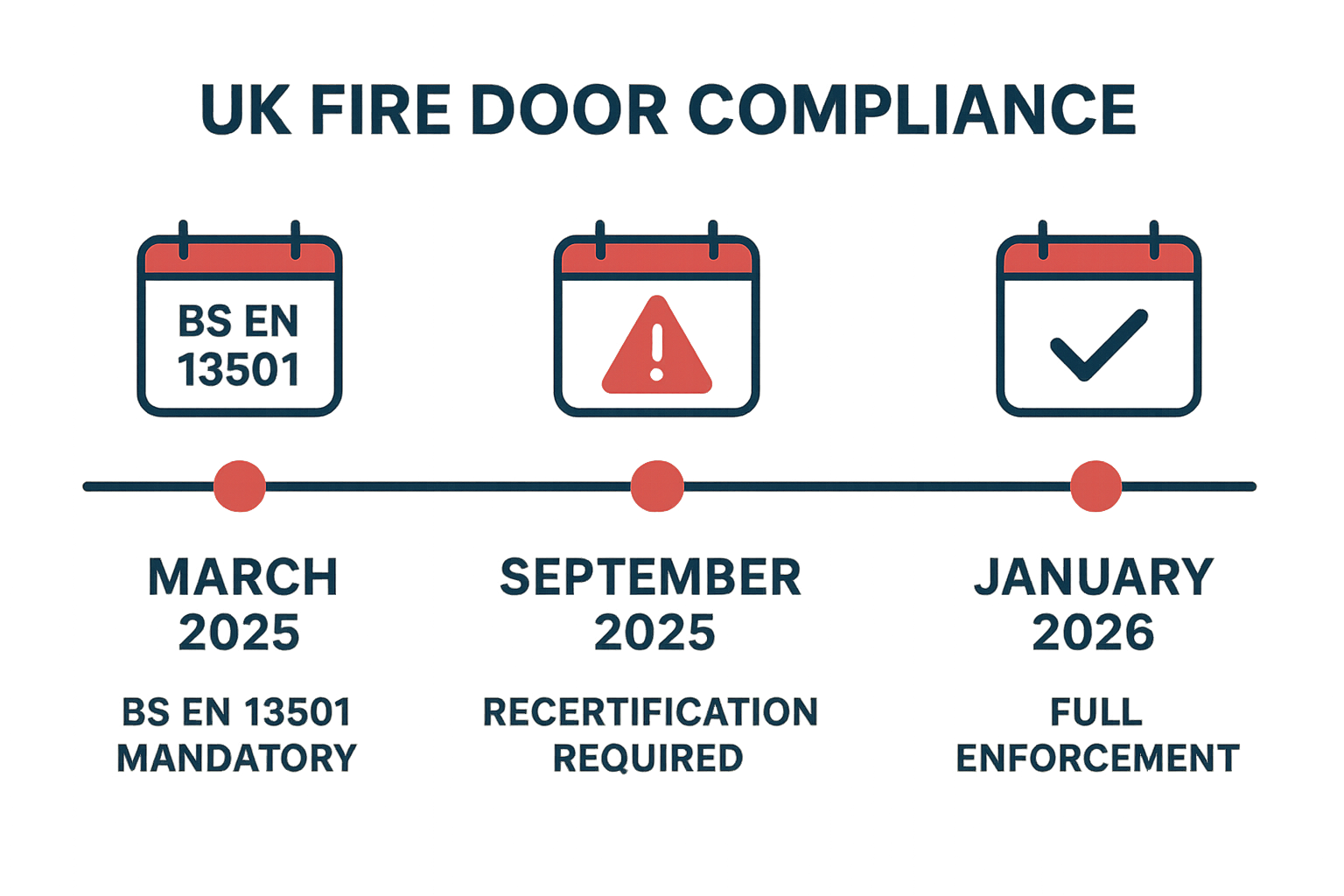
Figure 7: Implementation Timeline from March 2025 (BS EN 13501 mandatory) to January 2026 (full enforcement)
Enhanced Fire Safety Information Requirements
Regulation 38 introduces new documentation requirements that fundamentally change how fire safety information is provided and maintained. These requirements ensure that building owners and managers have access to comprehensive information about their fire safety systems.
New Documentation Requirements:
Contractors must now provide detailed fire safety information to Responsible Persons, including comprehensive specifications and performance data. Third-party certification of all fire door installations is mandatory, ensuring independent verification of compliance. Timely notification to building control authorities is required for all installations and modifications. Digital handover packages with maintenance schedules must be provided, ensuring ongoing compliance throughout the door’s lifecycle.
Information Must Include:
Complete fire door specifications and testing certificates that demonstrate compliance with current standards, installation methodology and quality assurance records that document proper installation procedures, maintenance requirements and inspection schedules that ensure ongoing performance, and emergency contact information for 24/7 support when issues arise.
This applies to all fire door types, including specialized applications like glazed fire doors and internal fire doors with glass, which require additional documentation for glazing systems.
Mandatory Sprinkler Systems in Care Homes
New requirements for care homes represent a significant expansion of fire safety requirements, recognizing the particular vulnerability of residents in these facilities.
Comprehensive Requirements:
All newly constructed care homes must now incorporate comprehensive sprinkler systems regardless of building height, robust fire door compartmentation integrated with sprinkler controls, enhanced evacuation procedures specifically designed for vulnerable residents, and digital monitoring systems that link fire doors and sprinklers for coordinated response.
Expanded Record-Keeping for Complex Buildings
Complex buildings now face significantly enhanced record-keeping requirements that ensure comprehensive documentation of all fire safety measures and procedures.
Required Documentation:
Complex buildings must maintain detailed fire safety strategies updated annually to reflect current conditions and requirements, operational procedures for all fire safety systems including fire doors and related equipment, “cause and effect” plans that link fire doors to alarm systems and other safety measures, and digital maintenance logs with real-time updating capabilities that provide immediate access to current status information.
Personal Emergency Evacuation Plans (PEEPs)
The introduction of mandatory Personal Emergency Evacuation Plans represents a significant advancement in protecting vulnerable individuals during fire emergencies.
Mandatory Implementation:
PEEPs are now required for vulnerable individuals in care homes and supported living facilities, hospitals and healthcare facilities, educational buildings with disabled access, and workplaces with mobility-impaired employees.
PEEP Requirements:
Each plan must include individual risk assessments for each vulnerable person, specific evacuation routes that account for fire door locations and accessibility, staff training on PEEP implementation and execution, and regular drills and procedure updates to ensure effectiveness. Understanding fire exit doors regulations UK is crucial for developing effective evacuation plans.
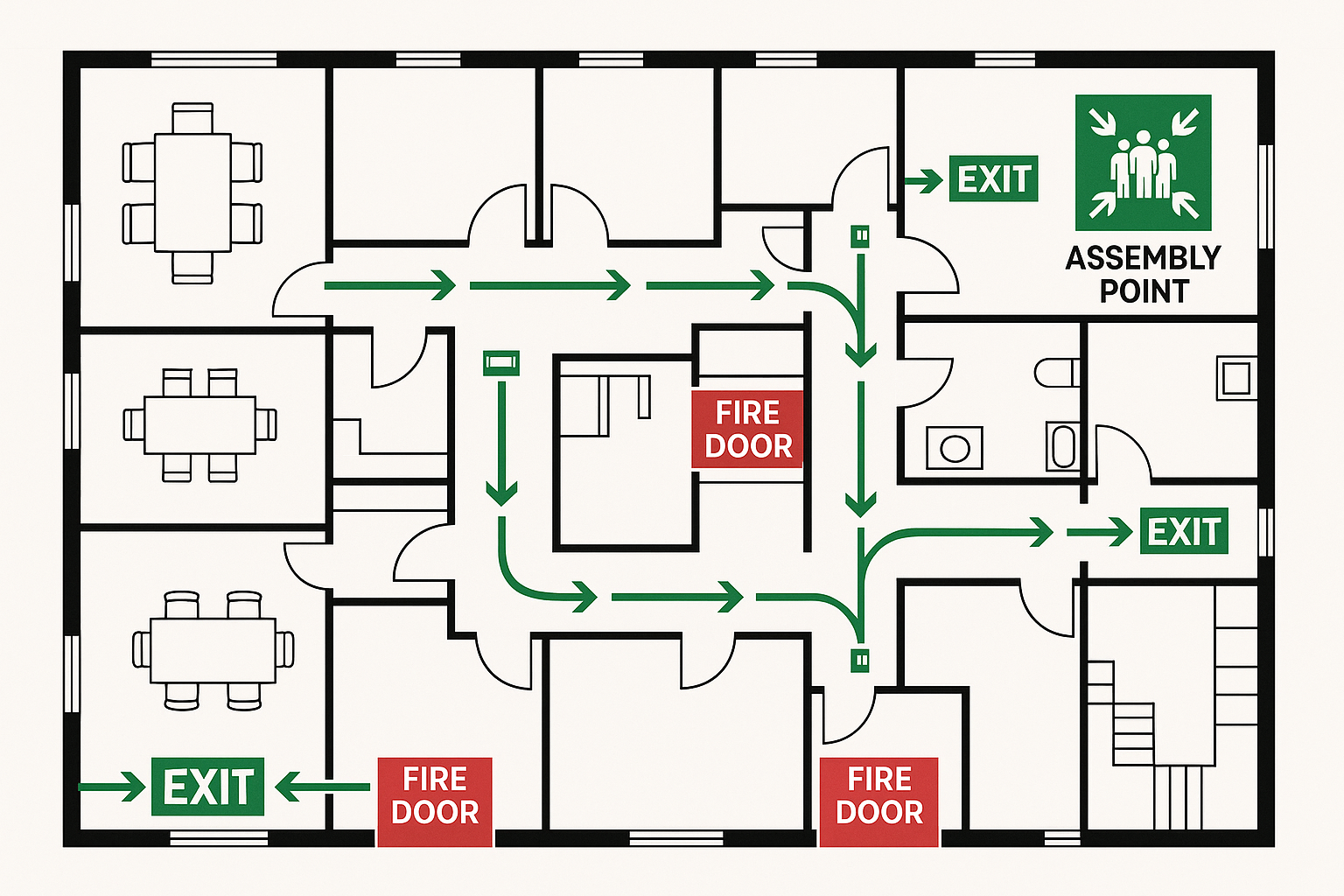
Figure 8: Building Floor Plan showing emergency evacuation routes with fire doors, escape paths, assembly points, and emergency exits
Enhanced Competence Requirements
New competence requirements for fire risk assessors ensure that only qualified professionals conduct fire safety assessments and provide guidance on compliance.
Qualification Standards:
Level 4 fire safety qualification is now the minimum standard for conducting fire risk assessments, BS EN 13501 training and certification is required for all assessors, annual competency assessment and Continuing Professional Development (CPD) compliance is mandatory, and professional indemnity insurance with minimum £10 million coverage is required.
Accredited Bodies:
Recognized accreditation comes from the Institution of Fire Engineers (IFE), Fire Industry Association (FIA), Q-Mark Fire Door Inspection Scheme, and FIRAS (Fire Industry Risk Assessment Scheme).
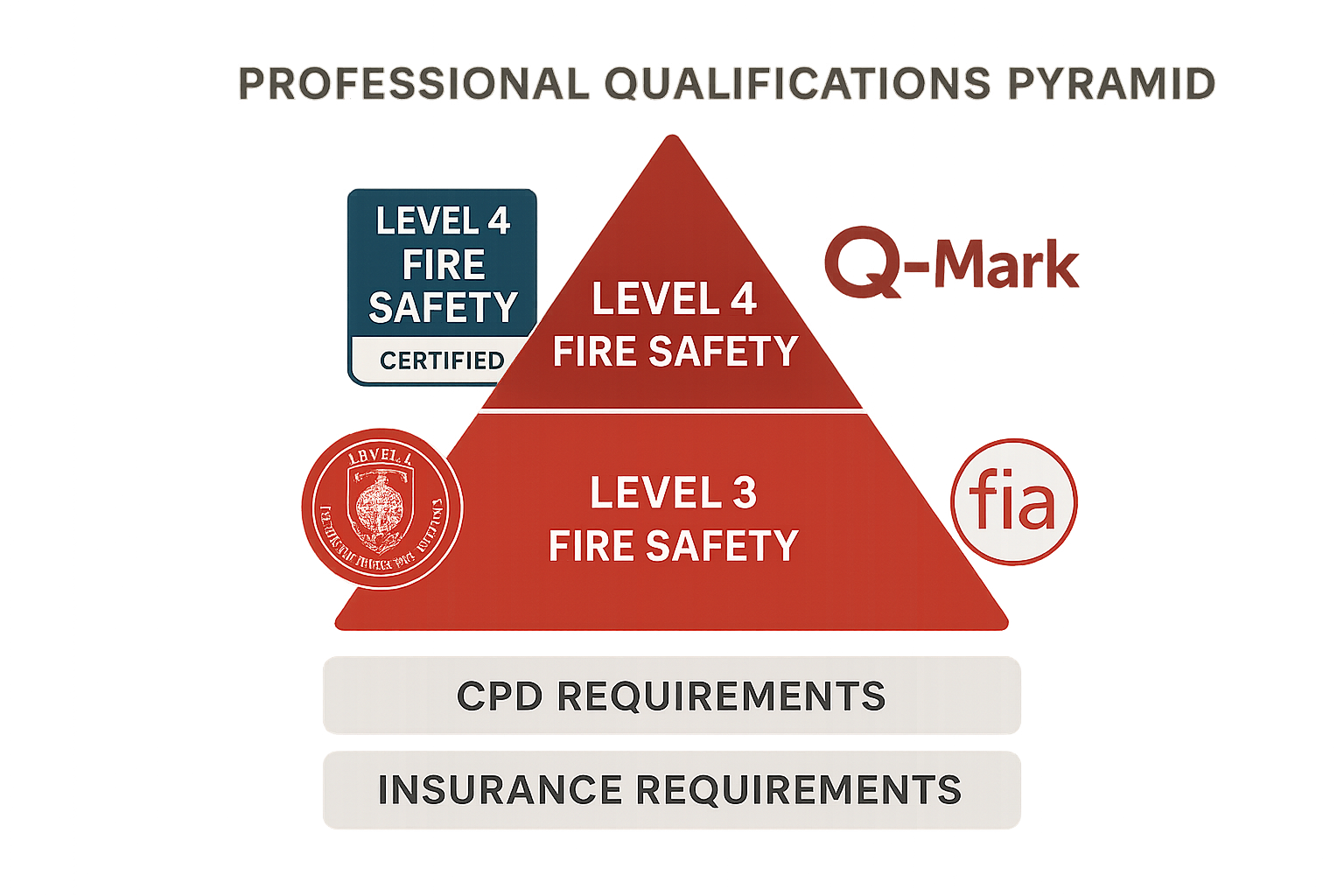
Figure 9: Professional Qualifications Pyramid showing Level 3 and Level 4 requirements, accreditation bodies, CPD requirements, and insurance requirements
Responsibilities and Legal Compliance: Who Does What and When
Understanding legal responsibilities is crucial for maintaining fire door compliance and avoiding prosecution under UK fire safety law. The designation of “Responsible Person” carries significant legal weight and personal liability that extends beyond simple regulatory compliance.
The Role of the Responsible Person: Ultimate Accountability
The “Responsible Person” bears ultimate legal accountability for fire door compliance, a designation that typically includes building owners, employers, and occupiers with control over premises. This role carries both civil and criminal liability, making it essential to understand the full scope of responsibilities and potential consequences.
Building Owners Face Comprehensive Obligations:
Freeholders of residential and commercial properties bear primary responsibility for fire door compliance, including ensuring all doors meet current standards and are properly maintained. Head lessees with repairing obligations must ensure fire doors remain compliant throughout lease terms. Management companies appointed by leaseholders must implement comprehensive fire door management programs. Local authorities responsible for social housing must ensure all fire doors meet enhanced standards for vulnerable populations.
For residential properties, understanding do I need fire doors in my house UK requirements helps homeowners determine their obligations, while commercial property owners must understand commercial fire doors requirements.
Employers and Occupiers Share Responsibility:
Company directors and senior management bear personal liability for workplace fire door compliance, with potential criminal prosecution for serious failures. Facilities managers and building coordinators must implement day-to-day compliance monitoring and maintenance programs. Health and safety officers with fire safety duties must ensure fire doors integrate with overall safety management systems. School governors and healthcare trust boards must ensure fire doors meet enhanced standards for vulnerable populations.
Legal Duties and Obligations: What the Law Requires
Fire risk assessment requirements form the foundation of legal compliance, requiring comprehensive assessment of all fire doors within premises, escape routes and evacuation procedures, vulnerable persons requiring assistance, and interface between different fire safety systems.
Documentation Requirements Ensure Accountability:
Written fire risk assessments must be updated annually and include comprehensive fire door evaluations. Fire door inspection records with photographic evidence must document current condition and compliance status. Staff training records and competency certificates must demonstrate ongoing education and awareness. Maintenance schedules and contractor certifications must ensure all work meets professional standards.
Professional fire risk assessment services ensure comprehensive compliance and reduce legal liability, while integration with asbestos survey requirements provides complete building safety coverage and understanding of asbestos poi soning signs in older buildings.
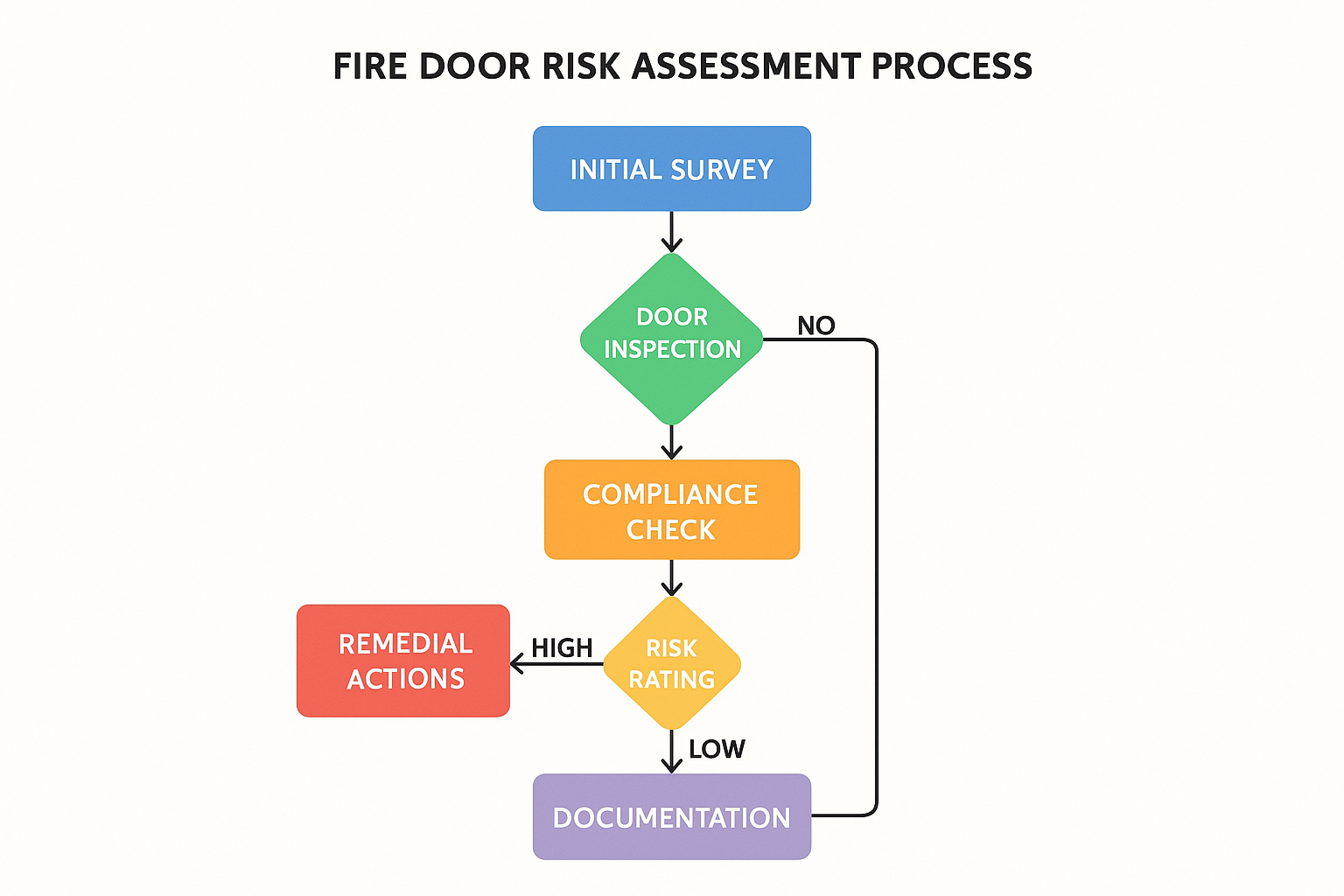
Figure 10: Step-by-step Fire Door Risk Assessment Process showing initial survey, inspection, compliance check, risk rating, remedial actions, and documentation
The “Best Endeavours” Standard: What Courts Expect
The Fire Safety (England) Regulations 2022 require Responsible Persons to use “best endeavours” for compliance, a legal standard that has been clarified through recent court cases and enforcement actions.
Best Endeavours Interpretation:
Courts have established that “best endeavours” requires all reasonable steps to ensure fire door functionality, professional expertise engaged where necessary, regular monitoring and maintenance programs, and prompt remedial action when defects are identified.
Legal Precedent from Recent Cases:
Recent court cases have established that “best endeavours” requires professional fire door surveys every 3-6 months, coordination with fire alarm testing schedules, immediate action on critical defects, competent contractors for all remedial works, understanding of asbestos poisoning signs in older buildings, and comprehensive documentation of all compliance efforts.
Delegation and Competency: Sharing Responsibility Safely
Responsible Persons may delegate duties but retain ultimate legal liability, making it essential to ensure proper delegation procedures and competency verification.
Competent Persons Requirements:
Formal fire safety qualifications (Level 3 minimum) are required for all delegated responsibilities, along with practical experience in fire door systems, current knowledge of regulations and standards, and professional indemnity insurance coverage.
Delegation Documentation:
Written appointment of competent persons must clearly define roles and responsibilities, clear scope of responsibilities and authority levels must be established, regular performance monitoring and competency reviews must be conducted, and backup arrangements for absence coverage must be in place.
Insurance and Liability Considerations: Protecting Your Investment
Professional indemnity requirements vary based on organization size and risk profile, with minimum coverage levels ranging from £2 million for individual consultants to £20 million+ for healthcare and education facilities.
Insurance Implications of Non-Compliance:
Policy invalidation for regulatory breaches can leave organizations without coverage when they need it most. Increased premiums for poor fire safety records reflect the elevated risk profile of non-compliant buildings. Exclusions for “known defects” not addressed can void coverage for fire-related incidents. Personal liability for directors and officers can extend beyond corporate protection in cases of gross negligence or willful non-compliance.
Fire Door Specifications and Technical Requirements: Getting the Details Right
Understanding technical specifications is essential for ensuring fire doors meet current UK standards and provide effective protection. The transition to BS EN 13501 standards has introduced new complexity that requires careful attention to detail and professional expertise.
Fire Resistance Classifications: The New European Standard
The BS EN 13501 European Standards implemented in March 2025 provide more detailed and accurate fire performance information than previous classification systems, enabling better decision-making and more effective fire safety planning.
Fire Resistance Periods:
R30 classification indicates 30 minutes fire resistance, typically used in residential applications where evacuation times are shorter and fire loads are generally lower. R60 classification provides 60 minutes fire resistance for commercial and high-risk applications where longer evacuation times may be required. R90 classification offers 90 minutes fire resistance for industrial and storage applications with high fire loads or complex evacuation requirements. R120 classification delivers 120 minutes fire resistance for critical infrastructure where extended protection is essential.
Integrity Classifications Provide Detailed Performance Data:
E classification indicates integrity only, measuring flame penetration resistance without considering temperature rise or radiation. EI classification combines integrity plus insulation, measuring both flame penetration and temperature rise on the non-fire side. EW classification includes integrity plus radiation limitation, measuring flame penetration and radiant heat transmission.
Additional Classifications Enhance Safety Understanding:
Smoke Control classifications Sa and S200 measure air leakage rates under different pressure conditions, crucial for maintaining safe evacuation routes. Automatic Closing classifications C0-C5 measure closing reliability under various conditions, ensuring doors close properly during emergencies. Durability classifications Class 1-8 indicate operational cycles the door can withstand while maintaining fire performance.
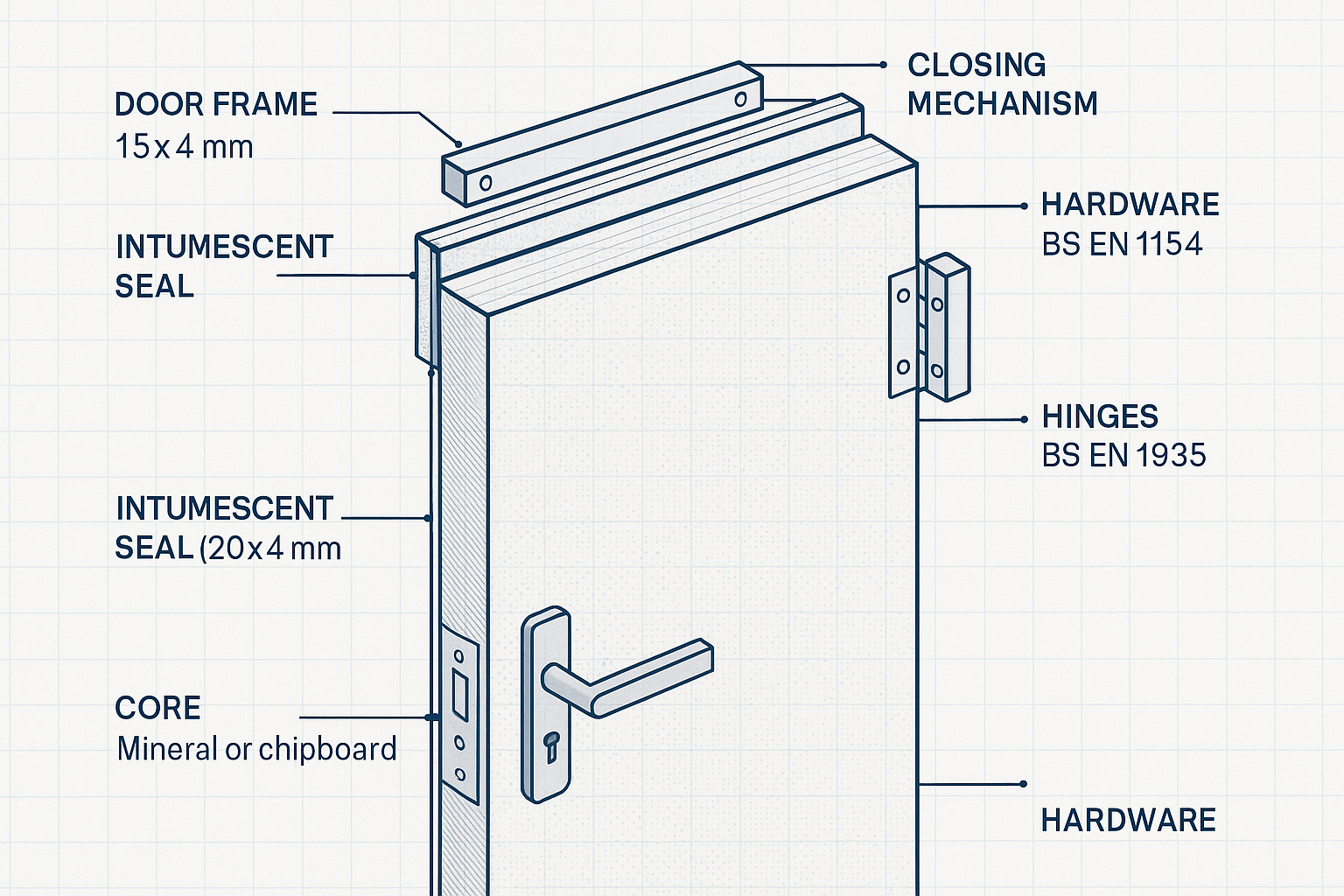
Figure 11: Essential Components of Compliant Fire Door Construction showing detailed cross-section with door frame, intumescent seals, hinges, closing mechanism, core materials, and hardware specifications
Essential Fire Door Components: Building Safety from the Ground Up
Door Leaf Construction:
Core materials must comply with BS EN 13501 standards, with mineral wool cores providing superior insulation properties for high-performance applications. Vermiculite boards offer structural integrity while maintaining fire resistance, particularly important in high-traffic applications. Chipboard cores with fire-resistant additives provide cost-effective solutions for standard applications. Steel-faced cores deliver maximum protection for high-security applications where both fire resistance and physical security are required.
Surface finishes must maintain fire performance while providing aesthetic appeal. Hardwood veneers with fire-resistant lacquers offer traditional appearance with modern fire protection, particularly popular in oak fire doors for heritage and high-end applications. Laminate finishes tested for fire performance provide durable, easy-to-clean surfaces for healthcare and educational applications. Steel sheet cladding delivers maximum durability for industrial environments. Specialist coatings for healthcare and cleanroom applications meet specific hygiene and contamination control requirements.
Frame Systems:
Timber frames require hardwood construction with certificated fire resistance, proprietary fixing systems for various wall types, adjustable frame designs for building tolerances, and weather seal integration for external applications.
Steel frames must include galvanized construction with fire-resistant coatings, welded corner joints for maximum strength, adjustable threshold systems for accessibility compliance, and integrated cable management for access control systems.
Specialized Fire Door Applications
Glazed Fire Door Systems:
Glazed internal fire doors require specialized glazing systems that maintain fire resistance while providing visibility. Fire-resistant glazing must be tested to the same standards as the door assembly, with appropriate glazing compounds and fixing systems. Vision panels must not exceed specified maximum sizes to maintain structural integrity.
Sliding Fire Door Systems:
Sliding fire doors present unique challenges for fire safety, requiring specialized closing mechanisms and sealing systems. These doors must close automatically during fire emergencies while maintaining ease of operation during normal use. Track systems must be designed to prevent derailment during building movement or thermal expansion.
Composite Fire Door Solutions:
Composite fire doors combine multiple materials to achieve specific performance characteristics. These doors often incorporate steel reinforcement with timber or other core materials to provide enhanced security while maintaining fire resistance. Surface finishes can be customized for specific aesthetic or functional requirements.
Hardware Requirements: The Critical Details
Hinges:
Fire-rated hinges must be tested to match the door’s fire resistance period, with stainless steel bearings for extended operational life, self-lubricating systems reducing maintenance needs, and security-rated options for high-risk applications.
Closing Devices:
Overhead door closers with adjustable force settings ensure proper closing while accommodating user needs. Concealed closers provide aesthetic appeal for high-end applications. Floor springs handle heavy-duty and high-frequency use in commercial environments. Electromagnetic hold-open systems integrate with fire alarm systems for automatic release during emergencies.
Locks and Latches:
Mortice deadlocks with fire-resistant materials maintain security while preserving fire performance. Panic hardware for emergency egress routes ensures rapid evacuation when needed. Access control integration with fire safety override maintains security while ensuring emergency access. Key operation from both sides provides flexibility where required by evacuation procedures.
Sealing Systems: Preventing Smoke and Flame Penetration
Intumescent Seals:
These critical components expand when heated (typically at 150°C+) to seal gaps between door and frame, prevent smoke and flame penetration, and maintain integrity throughout the fire resistance period.
Graphite-based seals work effectively for standard applications, while silicone-based seals handle high-temperature exposure in industrial environments. Combined seals with smoke control properties provide dual protection, and specialized seals for glazing applications maintain transparency while providing fire protection.
Installation and Maintenance:
Proper installation requires precise measurement and cutting, appropriate adhesive application, regular inspection for damage or displacement, and immediate replacement when compromised.
External Fire Door Considerations
External fire doors for flats require additional considerations for weather resistance while maintaining fire performance. These doors must withstand environmental exposure while providing the same level of fire protection as internal doors. Weather sealing systems must be compatible with fire sealing requirements, and hardware must be suitable for external use while maintaining fire ratings.
Fire-Rated vs Fire-Proof Terminology
Understanding the distinction between fire rated doors and fire proof doors is crucial for specification and compliance. Fire-rated doors are tested to specific time periods and performance criteria, while “fire-proof” is not a recognized technical term in UK regulations. All fire doors should be specified using proper fire resistance classifications.
Professional Inspection and Maintenance: Ensuring Ongoing Compliance
Professional inspection and maintenance form the backbone of fire door compliance, transforming regulatory requirements into practical safety measures that protect lives and property. The shift toward more stringent enforcement and higher penalties makes professional management essential rather than optional.
The Professional Inspection Imperative
Professional fire door surveys have evolved from recommended practice to legal requirement under current UK regulations. The Fire Safety (England) Regulations 2022 mandate professional surveys every 3-6 months for multi-occupied residential buildings, while best practice extends this requirement to all building types where fire doors provide critical protection.
What Professional Inspections Include:
Comprehensive visual examination of all door components identifies obvious defects and wear patterns that could compromise fire performance. Functional testing of closing mechanisms ensures doors close properly from any open position and latch securely. Gap measurement using specialized tools verifies compliance with maximum tolerances. Seal inspection checks for damage, displacement, or contamination that could reduce effectiveness. Hardware assessment ensures all components meet fire rating requirements and function correctly. Documentation review verifies installation certificates and maintenance records are current and complete.
The Competency Requirement:
Professional inspectors must hold Level 4 fire safety qualifications as the minimum standard, with BS EN 13501 training and certification for current standards. Annual competency assessment and Continuing Professional Development (CPD) compliance ensure inspectors maintain current knowledge. Professional indemnity insurance with minimum £10 million coverage protects building owners from inspector errors or omissions.
Accreditation from recognized bodies including the Institution of Fire Engineers (IFE), Fire Industry Association (FIA), Q-Mark Fire Door Inspection Scheme, or FIRAS (Fire Industry Risk Assessment Scheme) provides additional assurance of competency and professionalism.
Maintenance Programs: Preventing Problems Before They Occur
Effective maintenance programs prevent the majority of fire door failures while reducing long-term costs and ensuring consistent compliance. The key lies in understanding that fire doors are complex systems requiring specialized knowledge and regular attention.
Monthly Visual Inspections:
Building staff can conduct basic monthly inspections that identify obvious problems before they become serious safety issues. These inspections should check that doors close fully and latch properly from any open position, verify that seals and strips are intact and properly positioned, ensure hinges operate smoothly without binding or excessive noise, confirm that closing devices function correctly with appropriate force, and document any damage, wear, or unusual conditions for professional assessment.
Quarterly Professional Maintenance:
Professional maintenance every three months addresses issues beyond the scope of basic visual inspection. This includes lubrication of hinges and closing mechanisms using appropriate fire-rated products, adjustment of closing devices to ensure proper operation, replacement of damaged or worn seals and strips, minor repairs to door surfaces and hardware, and comprehensive documentation of all maintenance activities.
Annual Comprehensive Service:
Annual comprehensive service provides deep maintenance that extends door life and ensures continued compliance. This includes complete disassembly and inspection of closing mechanisms, replacement of wear items before failure occurs, comprehensive testing of all functions and adjustments, updating of maintenance records and compliance documentation, and planning for future maintenance needs and potential upgrades.
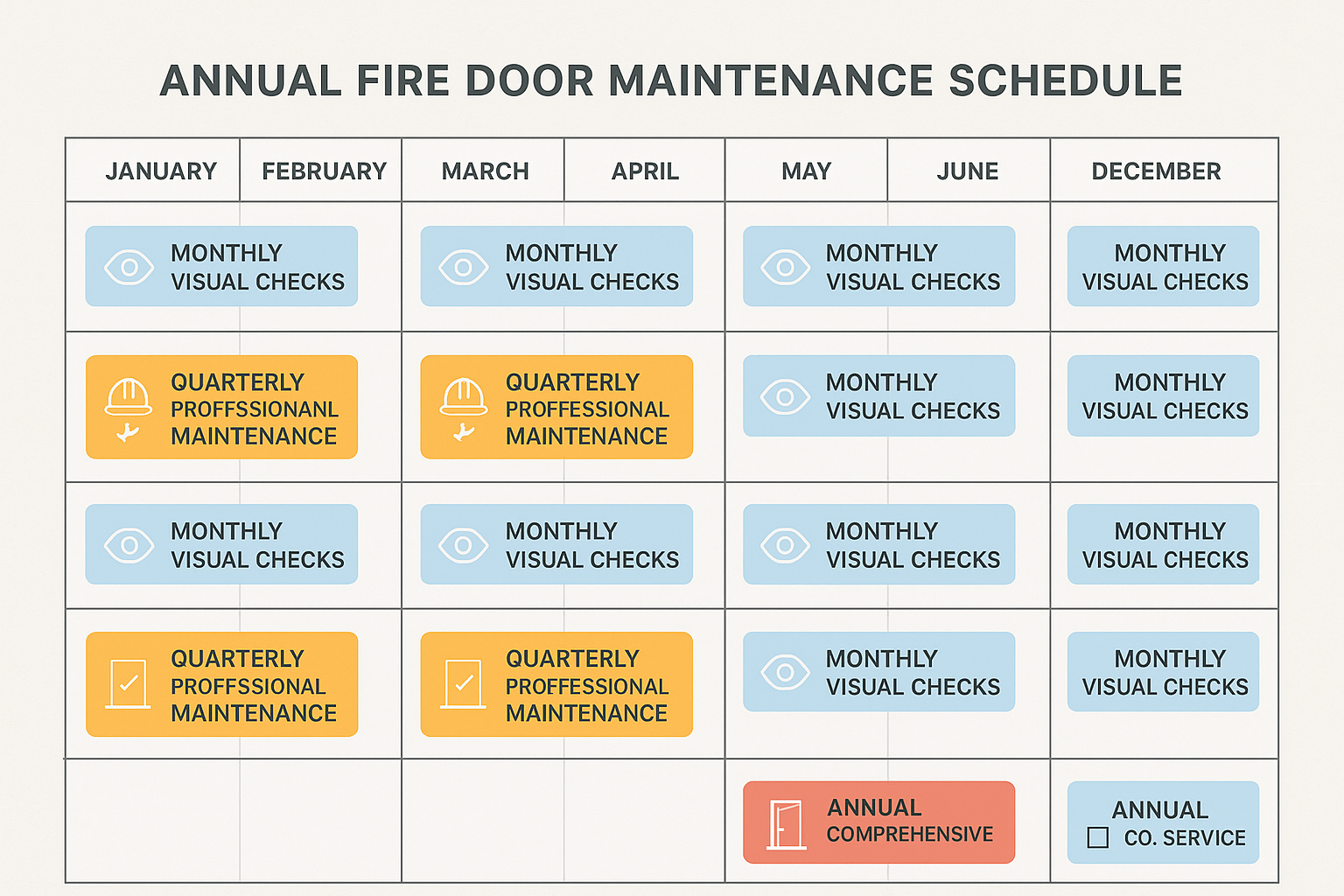
Figure 12: Annual Maintenance Schedule showing monthly visual checks, quarterly professional maintenance, and annual comprehensive service
Digital Monitoring: The Future of Fire Door Management
Digital monitoring systems represent the cutting edge of fire door management, providing real-time information about door status and performance while reducing the burden of manual inspection and documentation.
IoT Monitoring Systems:
Internet of Things (IoT) sensors installed on fire doors provide continuous monitoring of door position, closing time, and environmental conditions. These systems can detect when doors are propped open inappropriately, identify closing mechanism failures before they become critical, monitor environmental conditions that could affect door performance, and provide real-time alerts when intervention is required.
Benefits of Digital Monitoring:
Immediate notification of problems allows rapid response before safety is compromised. Automated documentation reduces administrative burden while ensuring comprehensive records. Predictive maintenance capabilities identify potential failures before they occur. Integration with building management systems provides centralized control and monitoring. Remote monitoring capabilities allow oversight of multiple buildings from a central location.
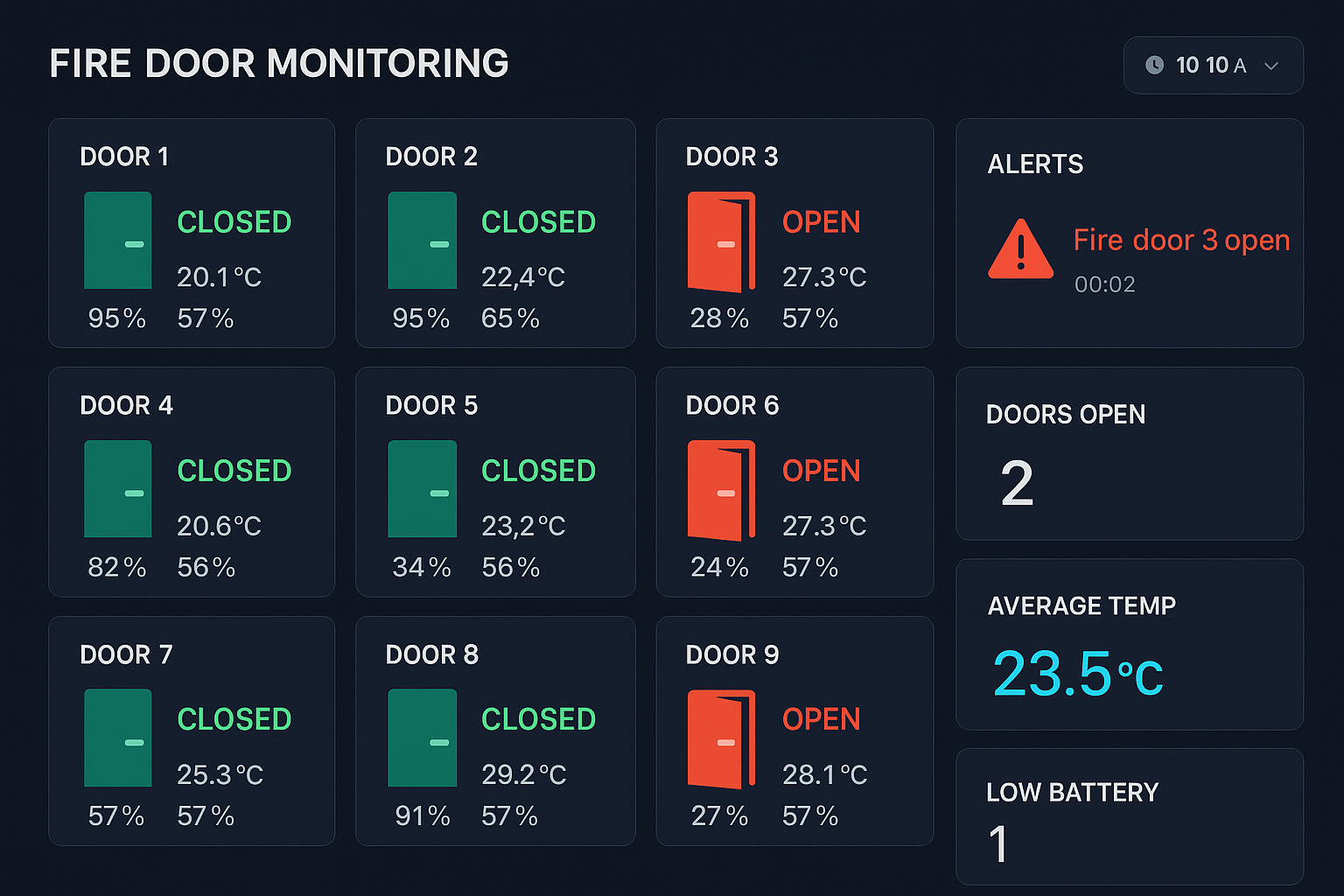
Figure 13: Real-time IoT Monitoring Dashboard showing door status, sensor data, alerts, and performance metrics
Implementation Considerations:
Digital monitoring systems require careful planning and professional installation to ensure effectiveness. Power supply and connectivity must be reliable and secure. Integration with existing building systems requires professional expertise. Staff training ensures effective use of monitoring capabilities. Regular system maintenance and updates maintain effectiveness and security.
Record Keeping: Documentation That Protects
Comprehensive record keeping serves multiple purposes: demonstrating compliance during inspections, providing evidence of due diligence in legal proceedings, tracking maintenance needs and costs, and ensuring continuity when staff changes occur.
Essential Records:
Installation certificates and specifications document that doors meet required standards from the beginning. Inspection reports with photographic evidence provide objective documentation of door condition over time. Maintenance records detail all work performed and materials used. Training records demonstrate staff competency and awareness. Incident reports document any problems and corrective actions taken.
Digital Record Management:
Modern record management systems provide secure, searchable storage of all fire door documentation. Cloud-based systems ensure records are accessible from any location while maintaining security and backup protection. Integration with inspection and maintenance scheduling automates record keeping and ensures nothing is overlooked. Mobile access allows field staff to update records immediately during inspections and maintenance.
Retention Requirements:
Current regulations require retention of fire door records for minimum periods ranging from 5 to 7 years depending on building type and specific requirements. Best practice extends retention periods to cover the full lifecycle of fire doors, typically 20-30 years. Digital storage makes long-term retention practical and cost-effective while ensuring records remain accessible and searchable.
Cost Analysis and Return on Investment: Making the Business Case
Understanding the financial implications of fire door compliance helps building owners make informed decisions about investment priorities and risk management. The cost of compliance must be weighed against the potentially catastrophic costs of non-compliance, including fines, legal liability, insurance implications, and most importantly, the human cost of fire safety failures.
The True Cost of Non-Compliance
Recent enforcement data reveals the escalating financial risks of fire door non-compliance. With 234 prosecution cases in 2024 resulting in average fines of £45,000, the financial consequences have never been more severe. The 65% increase in average fines from 2023 demonstrates the increasingly serious approach taken by enforcement authorities.
Direct Financial Penalties:
Average fines of £45,000 represent only the beginning of potential financial exposure. Maximum fines can reach unlimited amounts for serious breaches, particularly where life safety is compromised. Legal costs for defending prosecution cases typically range from £50,000 to £200,000, even for successful defenses. Criminal prosecution can result in custodial sentences for responsible persons, with 12 such sentences imposed in 2024.
Indirect Financial Consequences:
Insurance implications extend far beyond direct penalties. Policy invalidation for regulatory breaches can leave building owners without coverage when they need it most. Increased premiums for poor fire safety records can add tens of thousands of pounds to annual insurance costs. Exclusions for “known defects” not addressed can void coverage for fire-related incidents, potentially exposing building owners to unlimited liability.
Business Disruption Costs:
Fire safety enforcement actions can result in prohibition notices that prevent building use until compliance is achieved. Lost rental income during remediation periods can exceed the cost of proactive compliance by orders of magnitude. Reputation damage from prosecution or fire safety incidents can have long-lasting effects on property values and business relationships.
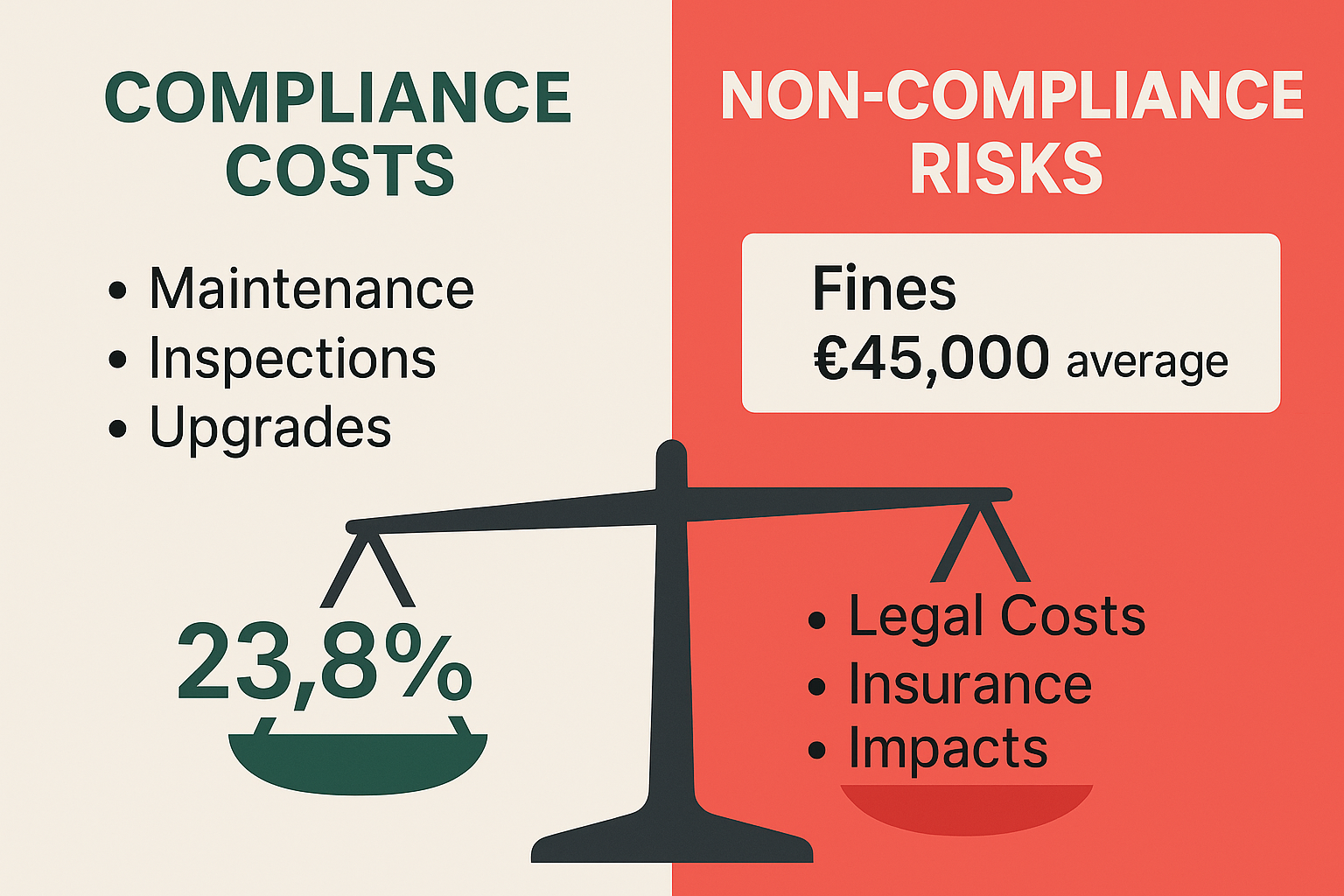
Figure 14: Financial comparison showing compliance costs (maintenance, inspections, upgrades at 23.8%) versus non-compliance risks (£45,000 average fines, legal costs, insurance impacts)
Investment in Compliance: Understanding the Costs
Professional fire door compliance requires significant upfront investment, but the costs are predictable and manageable when planned properly. Understanding the components of compliance costs helps building owners budget effectively and prioritize investments.
Initial Assessment and Survey Costs:
Professional fire door surveys typically cost £150-£300 per door depending on building complexity and location. Comprehensive building assessments for large properties may require £10,000-£50,000 investment but provide complete understanding of compliance requirements. Risk assessment updates to incorporate fire door findings typically add £2,000-£5,000 to survey costs.
Remediation and Upgrade Costs:
Fire door replacement costs vary significantly based on specification and installation complexity. Understanding cost of fire doors for flats helps residential property owners budget appropriately. Standard fire doors range from £800-£2,000 per door including installation. High-specification doors for healthcare or high-security applications can cost £3,000-£8,000 per door. Specialized doors for heritage buildings or unusual applications may require £10,000+ per door.
Repair and maintenance costs are generally much lower than replacement. Seal replacement typically costs £50-£150 per door. Closing mechanism adjustment or replacement ranges from £200-£800 per door. Hardware upgrades to meet current standards typically cost £300-£1,200 per door.
Ongoing Compliance Costs:
Professional inspection programs typically cost £75-£150 per door per year for quarterly inspections. Annual maintenance programs range from £100-£300 per door depending on door complexity and building requirements. Digital monitoring systems require £200-£500 per door initial investment plus £50-£100 per door annual monitoring costs.
Return on Investment: Quantifying the Benefits
Investment in fire door compliance generates returns through multiple channels, making it financially attractive even without considering regulatory requirements.
Risk Reduction Benefits:
Avoiding prosecution saves an average of £45,000 in fines plus legal costs. Insurance premium reductions for compliant buildings can save 10-25% annually on fire insurance costs. Reduced liability exposure protects against potentially unlimited damages in case of fire incidents.
Operational Benefits:
Professional maintenance extends fire door life by 50-100%, reducing replacement costs over time. Predictive maintenance prevents emergency repairs that typically cost 3-5 times more than planned maintenance. Improved building management systems reduce overall facilities management costs.
Property Value Enhancement:
Compliant buildings command premium rents and sale prices. Professional fire safety management demonstrates quality building management to tenants and buyers. Enhanced reputation attracts quality tenants and reduces vacancy periods.
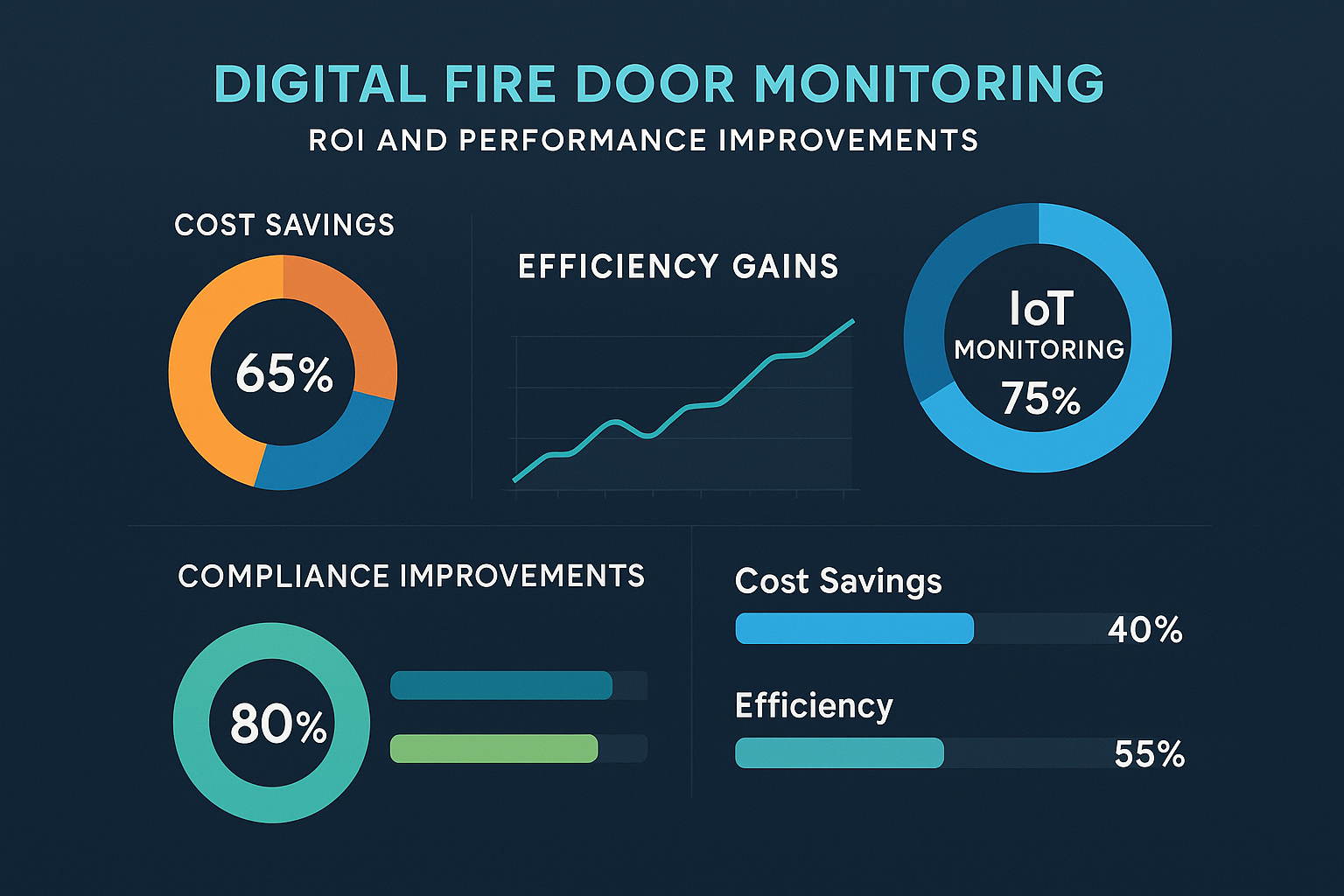
Figure 15: Comprehensive ROI Analysis for Digital Fire Door Management Systems showing 65% cost savings, 75% IoT monitoring efficiency, 80% compliance improvements, and 40% cost savings with 55% efficiency gains
Digital Monitoring ROI: The Technology Advantage
Digital monitoring systems provide exceptional return on investment through operational efficiency and risk reduction. While initial investment is significant, the long-term benefits typically justify costs within 2-3 years.
Efficiency Gains:
Automated monitoring reduces manual inspection costs by 60-80%. Real-time alerts prevent minor issues from becoming major problems. Predictive maintenance reduces emergency repair costs by up to 75%. Centralized monitoring allows management of multiple buildings from single locations.
Compliance Benefits:
Automated documentation ensures comprehensive records without administrative burden. Real-time compliance monitoring provides immediate notification of issues. Integration with building management systems streamlines overall facilities management. Professional reporting capabilities simplify regulatory compliance and inspection processes.
Long-term Value:
Digital systems provide data analytics that improve decision-making over time. Integration capabilities allow expansion to other building systems. Technology updates maintain cutting-edge capabilities without complete system replacement. Scalability allows cost-effective expansion as building portfolios grow.
Making the Investment Decision
The business case for fire door compliance investment is compelling when all factors are considered. The combination of regulatory requirements, financial risks, and operational benefits makes professional fire door management essential for responsible building ownership.
Investment Priorities:
Immediate professional assessment provides foundation for all other decisions. Critical safety issues require immediate attention regardless of cost. Systematic remediation programs spread costs over manageable timeframes. Digital monitoring systems provide long-term efficiency and compliance benefits.
Financing Options:
Many building owners find that compliance investments can be financed through operational savings and risk reduction benefits. Insurance premium reductions often offset significant portions of compliance costs. Energy efficiency improvements from better door sealing can provide additional operational savings. Property value enhancement can justify investment through improved asset values.
The key to successful fire door compliance investment lies in understanding that this is not simply a regulatory cost – it’s an investment in building safety, operational efficiency, and long-term property value that provides returns far exceeding the initial investment.
Conclusion: Taking Action for Safety and Compliance
The fire door compliance crisis facing the United Kingdom in 2025 demands immediate, decisive action from building owners, managers, and responsible persons across all sectors. With 85% of fire doors failing professional inspections and average fines reaching £45,000, the time for gradual improvement has passed – comprehensive action is required now.
The Path Forward: Your Action Plan
Immediate Actions (Next 30 Days):
Schedule professional fire door surveys for all buildings under your control. Engage qualified assessors with Level 4 fire safety qualifications and current BS EN 13501 certification. Document current compliance status with photographic evidence and detailed reports. Identify critical safety issues requiring immediate attention. Implement temporary safety measures where necessary to protect occupants while planning comprehensive remediation.
Short-term Planning (Next 90 Days):
Develop comprehensive remediation plans with qualified contractors. Prioritize critical safety issues and high-risk areas. Establish maintenance programs with professional service providers. Implement staff training programs to ensure ongoing awareness and compliance. Update fire risk assessments to incorporate fire door findings and remediation plans.
Long-term Strategy (Next 12 Months):
Consider digital monitoring systems for enhanced compliance management. Establish relationships with qualified professional service providers. Develop budget planning for ongoing compliance costs. Implement quality management systems to ensure consistent compliance across all properties. Plan for regulatory updates and changing requirements.
The Technology Opportunity
Digital monitoring systems represent the future of fire door management, providing real-time compliance monitoring, predictive maintenance capabilities, and comprehensive documentation. While initial investment is significant, the long-term benefits in operational efficiency, risk reduction, and compliance assurance make digital systems increasingly attractive for professional building management.
Professional Support: When to Seek Help
Fire door compliance requires specialized knowledge and professional expertise. Building owners should engage professional support for initial assessments, complex remediation projects, ongoing maintenance programs, and digital system implementation. The cost of professional support is minimal compared to the risks of non-compliance and the benefits of effective fire door management.
Final Thoughts: Safety as the Priority
While this guide has focused extensively on regulatory compliance and financial considerations, the fundamental purpose of fire door requirements is protecting human life. Every fire door in your building represents a critical barrier between occupants and potentially fatal fire and smoke. Professional fire door management is not just about avoiding fines or meeting regulations – it’s about ensuring that everyone who enters your building can exit safely in an emergency.
The investment in fire door compliance is an investment in human safety, regulatory compliance, operational efficiency, and long-term property value. With professional support, systematic planning, and commitment to ongoing maintenance, building owners can achieve comprehensive compliance while protecting their most important asset – the safety of building occupants.

